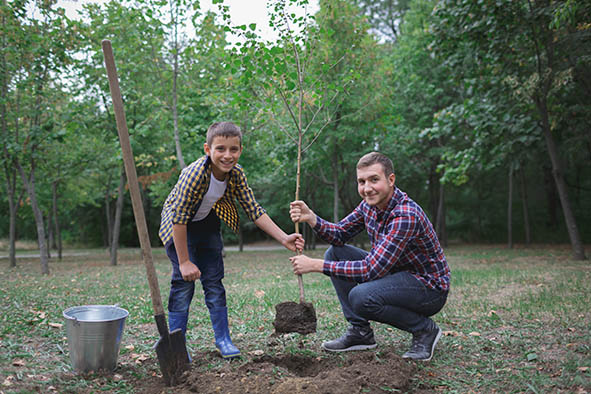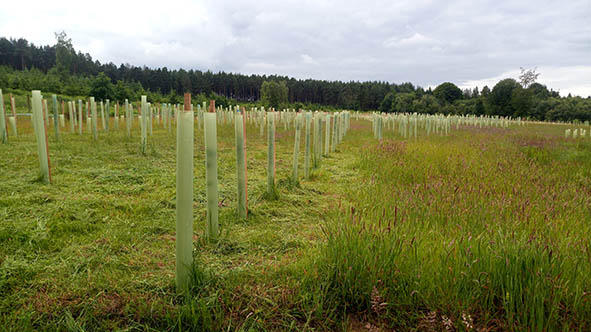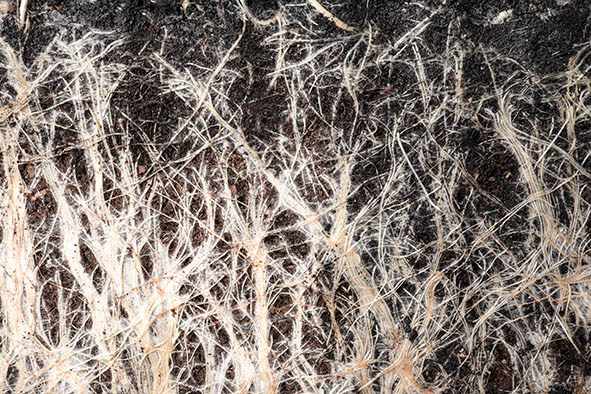Here, our Principal Ecologist, Sue Searle talks about how to plant trees and how to ensure the best start for the trees.
I am personally not a big fan of current practices in tree planting; it seems to be going on all over the place with little regard to the species being planted, the land they are being planted on and the aftercare. Many road schemes and land restoration projects seem to be struggling to get the trees to grow. Here are some top tips on how to plant trees to ensure your trees have the best start in life.

Choose the Right Tree Species to Plant
Before planting a tree, it’s important to choose the right species that will thrive in the local climate and soil conditions. I like to look at what is locally typical – some species of trees only live in limey soils, and others only in poor soils. If you look around the area, you will see which species do best there, and you can plant them. Most people plant a tree pack which contains a set mix of trees. These may not be suitable for the site you want to plant them on. If in doubt, seek advice from an ecologist and have a look at the list at the bottom of this article.
Plant in the right location
Consider factors like sunlight, soil type, and drainage when selecting a location for planting trees. Avoid planting near power lines, buildings, or other structures that may interfere with the tree’s growth or present a danger. Avoid planting trees in unsuitable soils – I once witnessed a team planting oaks in waterlogged soil. It would have been much better to plant willows or alder.
Another thing to consider is the end height of the tree. Oaks will always grow to a large size, whilst blackthorn will usually stay under 3-4 m. Maybe plant your canopy trees in the centre of new woodland and the shrubby species around the edges. Some trees need full light, such as blackthorn and rowan, so avoid planting them under larger trees. Others, like hazel and holly, tolerate shade, so you can plant them within the woodland.
Use Correct Spacing
The correct spacing will depend on what you are aiming for as the end result. For example, close planting for hedgerow creation can be as little as 10-20cm apart. For a woodland, 2-5m apart is a good space. If it is 1m apart, then you will get a thicket, and some trees will outcompete others leading to trees dying. Try to avoid planting in regimented rows if you are wanting a more natural feel to the woodland.
How to Plant Trees at The Right Time:
The best time to plant trees in the UK is during the dormant season, which is typically between November and March. I have seen tree planting done in July, followed by a scorching hot period, and the trees were not watered. Needless to say, 95% of the trees did not survive. It was a waste of time and money, and the project ended up with virtually no trees.
Prepare the Soil
Make sure the soil is well-prepared before planting trees. Start by removing any weeds or grass, and if possible, add compost or other organic matter to the soil to help improve its fertility.
Dig the hole: The hole should be deep enough to accommodate the root ball and wide enough to allow the roots to spread out. The depth of the hole should be the same as the depth of the root ball. Ensure not to bury any of the trunk or leave any roots exposed.
How to Plant Trees
Place the tree in the hole, making sure the top of the root ball is level with the ground. Fill the hole with soil and tamp it down firmly. You will need to put a tree guard on if the tree is small. Shorter guards will suffice if there are only rabbits and voles; taller ones are needed to prevent deer browsing. However, you should make sure the guards are biodegradable and will expand as the tree grows (spiral ones are good). If you are planting a row of trees of a hedgerow, consider surrounding the planting with fencing rather than using separate guards. You will get a bushier hedgerow that way.

Water the Tree
Water the tree thoroughly after planting to help settle the soil around the roots. After that, water the tree regularly, especially during dry spells. If you are planting bare root whips, then ideally water them in as you refill the hole around the roots to help the soil get good contact with the roots. It is preferable to water the tree regularly until it establishes, especially if there is a lack of rain, this can take around a year. Choose a time when it is likely to rain for your tree planting so nature can do the work for you at first.
Mulch Around The Tree
Mulch helps to retain moisture in the soil and suppress weeds that could compete with the tree. Spread a layer of organic mulch, such as wood chips, rotting leaves, sheep’s wool, shredded bark or mulch mats, around the base of the tree. It is important that this is biodegradable as it won’t be needed once the tree is a few feet tall.
Once the trees are planted, it is important that they are cared for, at least until they are established. Here are some suggestions for ongoing maintenance:
- Water the tree until it is established.
- Check the tree guards for weed growth inside the tube at least twice a year. These can hold moisture that is not good for the tree.
- Prune the tree regularly to remove any dead or diseased branches and promote healthy growth.
- Keep an eye on the tree over time to make sure it’s growing well and not suffering from any pests or diseases.
- Have a plan for when the tree guards will be removed. Even biodegradable ones will last for many years, and the tree needs to fend for itself at some point. Guards prevent the natural bending in the wind, which strengthens the tree, and also retain weeds and dampness, which can harm the tree. Depending on the species will depend on when you remove them but aim for when the tree has a reasonable girth and is growing well.
Seed or Tree?
As I said at the beginning, I am not a big fan of tree planting. Trees are perfectly capable of dispersing their seeds either by wind or with helpers like squirrels and jays. If your land is next to some trees, then just stop grazing or mowing it and allow the trees to self-seed. They will grow just as quickly as a whip but cost you nothing. Be aware that if brambles start to establish, these actually act as tree guards to prevent grazing by deer which are very useful.
Here are some reasons why it is better to plant seeds or allow natural regeneration of trees rather than tree planting:
Better Genetic Diversity
When trees are allowed to regenerate naturally, the resulting trees are likely to have a greater genetic diversity than trees that are planted. On top of this, the seeds will be from the local trees that have a natural resilience to the climate, pests and soils. This can help to increase the resilience of the forest ecosystem, making it better able to adapt to changing conditions.
Lower Cost
Natural regeneration is usually less expensive than tree planting. Planting trees requires a lot of resources, including labour, equipment, and seedlings. In contrast, natural regeneration requires little to no investment beyond protecting it from grazers until it is established.
Better Survival Rates
Trees that are naturally regenerated are often better adapted to local conditions and have a higher survival rate than planted trees. This is because they have grown from seeds that have already adapted to the local environment and the soils, and the seeds work with the fungal mycorrhizae in the soils to increase water and nutrient capture.
Better Biodiversity
When forests are allowed to naturally regenerate, they will, after time, have a greater variety of tree species, understory plants, and wildlife. This helps to increase biodiversity and create a healthier forest ecosystem.
More Sustainable
Natural regeneration is a more sustainable approach to forest management because it does not require the ongoing planting of new trees. Instead, the forest is allowed to naturally regenerate over time. Other effects like lack of care and leaving tree guards on do not occur – it is all natural.
There are still times when tree planting is necessary, such as in areas where the forest has been severely degraded or destroyed, or new habitats are being created after road building or developments. In these cases, planting trees may be the best option for creating wooded areas.
And What About The Fungi?
Fungi and mycorrhizae are important considerations when planting trees because they play a critical role in the health and growth of trees. Mycorrhizae are the tiny filaments of fungi in the soil that live in a mutually beneficial relationship with the roots of trees. They form a symbiotic association where the fungus provides the tree with nutrients, such as phosphorus and nitrogen, while the tree provides the fungus with carbohydrates. The mycorrhizae are also important for water retention in the soils as they improve soil structure. Avoid over digging, ploughing or driving vehicles over soil as the stucture could get damaged.

Planting Trees with Fungi in Mind
Here are some reasons why it is important to consider fungi and mycorrhizae when planting trees:
- Mycorrhizae help trees to absorb nutrients from the soil, particularly phosphorus, which can be in short supply in some areas. This can help trees to grow faster and more efficiently.
- Mycorrhizae can also help trees to withstand drought conditions by improving their ability to absorb water from the soil.
- Some mycorrhizal fungi have been shown to help trees resist diseases and pests, such as root rot and nematodes.
- Mycorrhizae can even help trees communicate with each other (the Wood Wide Web) by transferring messages about pests and diseases and helping each other when they are stressed or shaded out by bigger trees.
- Ecosystem function: Mycorrhizae are an important component of forest ecosystems, and their presence can help to support a diverse range of other plant and animal species.
When planting trees, it is important to consider the presence of mycorrhizae in the soil and to take steps to protect them. For example, disturbing the soil too much or using certain types of fertilizers can harm mycorrhizae. Planting trees in areas where mycorrhizae are present can help to ensure that the trees have access to the nutrients they need to grow and thrive. Additionally, in depleted soils, using mycorrhizal inoculants when planting trees can help to establish a healthy relationship between the trees and fungi.
I hope this article has been of some use to you and makes you plan and consider your tree planting more carefully. We have courses on Woodland Management, Habitat Management and Habitat Restoration – look on our website under courses.
Below I give a list of native trees for different soil types and conditions:
Calcareous soils:
English oak
Small-leaved line
Wild service tree
Wild cherry/bird cherry
Hawthorn
Wayfaring tree
Blackthorn
Field maple
Whitebeam
Wild privet
Ash
Hornbeam
Wych elm
Sandy or poor soils:
Scots pine
Juniper
Sea buckthorn
Downy birch
Silver birch
Grey willow
European gorse
Rowan
Alder buckthorn
Holly
Rich soils:
English oak
Ash
Hazel
Silver birch
Wild cherry
Beech
Small-leaved lime
Wild service tree
Field maple
Wych elm
Damp areas:
Willows
Alder
Downy birch
Alder buckthorn
Shaded areas:
Hazel
Holly
Rowan
Wild service
Yew
Small leaved lime
Beech
Alder buckthorn
Blackthorn
Check out this video by Ecology Training UK’s founder and head tutor Sue on how to identify some common trees in the UK.



